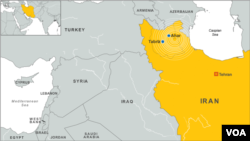Iran has raised the death toll from Saturday's two earthquakes to more than 300, a day after rescuers called off the search for survivors.
Health Minister Marzieh Vahid Dastjerdi told a session of parliament Monday that the latest death toll stood at 306, with more than 3,000 injured.
The Iranian Red Crescent estimates that 180 villages were damaged with some completely destroyed near the city of Tabriz. The 6.4 and 6.3 magnitude quakes struck minutes apart late Saturday afternoon.
Dozens of aftershocks have rumbled through the area, prompting thousands of people to spend their nights outdoors.
A spokeswoman for the International Federation of Red Cross and Red Crescent Societies tells VOA from Geneva that they are working closely with Iran's Red Crescent and that they have set up 6,000 tents to accommodate an estimated 16,000 people who are displaced. They are also providing basic supplies and blood donations for the victims.
The office of UN chief Ban Ki-moon released a statement Monday expressing the Secretary-General's condolences and offering humanitarian support.
The United States on Sunday offered help and condolences to the people of Iran. The White House statement was addressed to the "Iranian people" and said the U.S. stands ready "to offer assistance in this difficult time," but made no mention of the Iranian government.
Earthquakes are common in Iran, but few are significant enough to be noticed. The last major earthquake in Iran was a magnitude 6.6 quake in 2003 in the southeastern city of Bam, where 30,000 people died.
Health Minister Marzieh Vahid Dastjerdi told a session of parliament Monday that the latest death toll stood at 306, with more than 3,000 injured.
The Iranian Red Crescent estimates that 180 villages were damaged with some completely destroyed near the city of Tabriz. The 6.4 and 6.3 magnitude quakes struck minutes apart late Saturday afternoon.
Dozens of aftershocks have rumbled through the area, prompting thousands of people to spend their nights outdoors.
A spokeswoman for the International Federation of Red Cross and Red Crescent Societies tells VOA from Geneva that they are working closely with Iran's Red Crescent and that they have set up 6,000 tents to accommodate an estimated 16,000 people who are displaced. They are also providing basic supplies and blood donations for the victims.
The office of UN chief Ban Ki-moon released a statement Monday expressing the Secretary-General's condolences and offering humanitarian support.
The United States on Sunday offered help and condolences to the people of Iran. The White House statement was addressed to the "Iranian people" and said the U.S. stands ready "to offer assistance in this difficult time," but made no mention of the Iranian government.
Earthquakes are common in Iran, but few are significant enough to be noticed. The last major earthquake in Iran was a magnitude 6.6 quake in 2003 in the southeastern city of Bam, where 30,000 people died.
| Date | Magnitude | Location | Death Toll |
| August 11, 2012 | 6.4 and 6.3 | Near Tabriz | More than 300 |
| February 22, 2005 | 6.4 | Zarand | 600 |
| December 26, 2003 | 6.8 | Bam | 30,000 |
| May 10, 1997 | 7.1 | Northeastern Iran | 1,500 |
| June 20, 1990 | 7.3 | Rasht-Qazvin-Zanjan | 50,000 |








